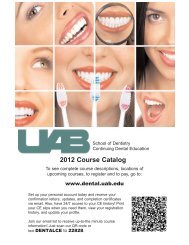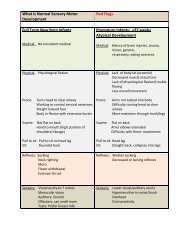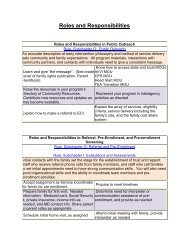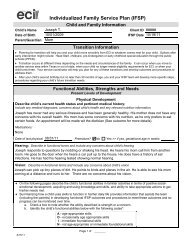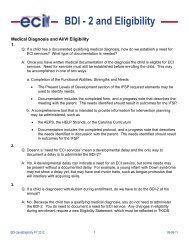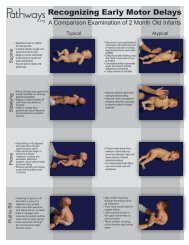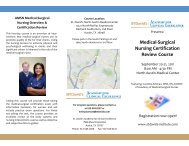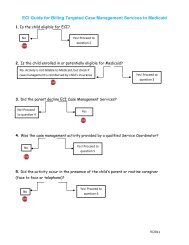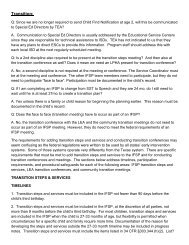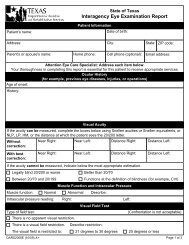6 Months
6 Months
6 Months
Create successful ePaper yourself
Turn your PDF publications into a flip-book with our unique Google optimized e-Paper software.
Recognizing Early Motor Delays<br />
A Comparison Examination of 6 Month Old Infants<br />
Typical<br />
Atypical<br />
Supine<br />
• Able to symmetrically lift and<br />
sustain upper and lower<br />
extremities against gravity<br />
• Demonstrates increased<br />
antigravity control of the muscles<br />
of the trunk and increased<br />
freedom of extremity movement<br />
• Exhibits quick visual-motor<br />
response of looking, reaching,<br />
grasping and transferring objects<br />
• Shows improved ability to hold head<br />
and trunk in midline, but still without<br />
adequate antigravity movement<br />
• Has excessively abducted and<br />
externally rotated upper and lower<br />
extremities, with movement primarily<br />
on the surface<br />
• Appears visually interested in objects<br />
but unable to reach and grasp<br />
Sidelying<br />
• Rolls independently and easily<br />
from supine through sidelying<br />
into prone in either direction<br />
• Shows active head righting and<br />
upper extremity pushing against<br />
the surface to raise body while<br />
reaching with the other hand<br />
• Requires assistance from<br />
examiner in rolling from<br />
supine to sidelying<br />
• Unbalanced neck, shoulder<br />
and back extension prevents<br />
use of the arm to assist in the<br />
rolling maneuver<br />
Prone<br />
• Bears weight on extended arms<br />
and forearms, with extension into<br />
the lumbar<br />
spine and lower extremities<br />
• Shows emerging upper extremity<br />
control in weight shifting for<br />
reaching, grasping and playing<br />
• Grasps toy towards thumb side<br />
of palm<br />
• Does not choose prone position<br />
for play due to decreased head,<br />
shoulder and trunk control<br />
• Has decreased upper extremity<br />
power, preventing weight shift<br />
towards the pelvis necessary for<br />
freedom in the upper extremities<br />
• Positions elbows behind<br />
shoulders, preventing head and<br />
trunk lifting<br />
Pull to Sit<br />
• Responds quickly and assists in<br />
the maneuver by actively flexing<br />
neck and lifting head<br />
• Also uses activity in the upper<br />
extremities and abdominals to assist<br />
• Shows good symmetry in the head,<br />
neck and upper extremities<br />
• Assists minimally in the pull to<br />
sit maneuver<br />
• Demonstrates complete head<br />
lag until the upright position<br />
• Does not assist with upper<br />
extremity pulling
Typical<br />
Recognizing Early Motor Delays<br />
A Comparison Examination of 6 Month Old Infants<br />
Atypical<br />
Sitting<br />
• Shows stable head and trunk<br />
control with active extension<br />
through the thoracic spine<br />
• Reaches with one arm at a time,<br />
using a wide base of support in<br />
the lower extremities<br />
• Struggles to maintain head<br />
upright and in midline; cannot<br />
activate vision or explore because<br />
so much effort is required to<br />
remain upright<br />
• Must be supported high up in the<br />
chest for stability<br />
• Exhibits decreased trunk<br />
extension and freedom to reach<br />
Horizontal Suspension<br />
• Demonstrates full, sustained<br />
extension in the neck and upper<br />
thoracic spine, down through the<br />
hips and legs<br />
• Lifts head in midline and<br />
extends through the upper<br />
thoracic spine only briefly<br />
• Does not exhibit extension<br />
through the spine and hips<br />
Protective Extention<br />
• Easily and quickly brings<br />
arms forward in a full protective<br />
response when tipped toward<br />
the surface<br />
• Props immediately on one upper<br />
extremity when reaching for a toy<br />
• Does not bring upper extremities<br />
forward to the surface in a<br />
protective response<br />
• Displays inadequate antigravity<br />
neck and trunk strength to free<br />
the arms to come forward<br />
Standing<br />
• Exhibits immediate sustained<br />
weight bearing on extended<br />
lower extremities; turns head<br />
freely to look around<br />
• Keeps hips slightly flexed and<br />
somewhat behind the shoulders<br />
• Uses upper extremities to assist<br />
in stabilizing the trunk<br />
• Fails to initiate or sustain active<br />
weight bearing when placed in<br />
supported standing<br />
• Lacks necessary antigravity head<br />
and trunk control<br />
• Unable to align head, trunk, hips,<br />
knees and feet in the vertical<br />
For more information please contact<br />
Pathways.org<br />
Toll-free (800) 955-2445 · Fax (888) 795-5884 · TTY (800) 326-8154<br />
http://www.pathways.org · friends@pathways.org<br />
Copy freely, do not change. Must acknowledge Pathways.org.



